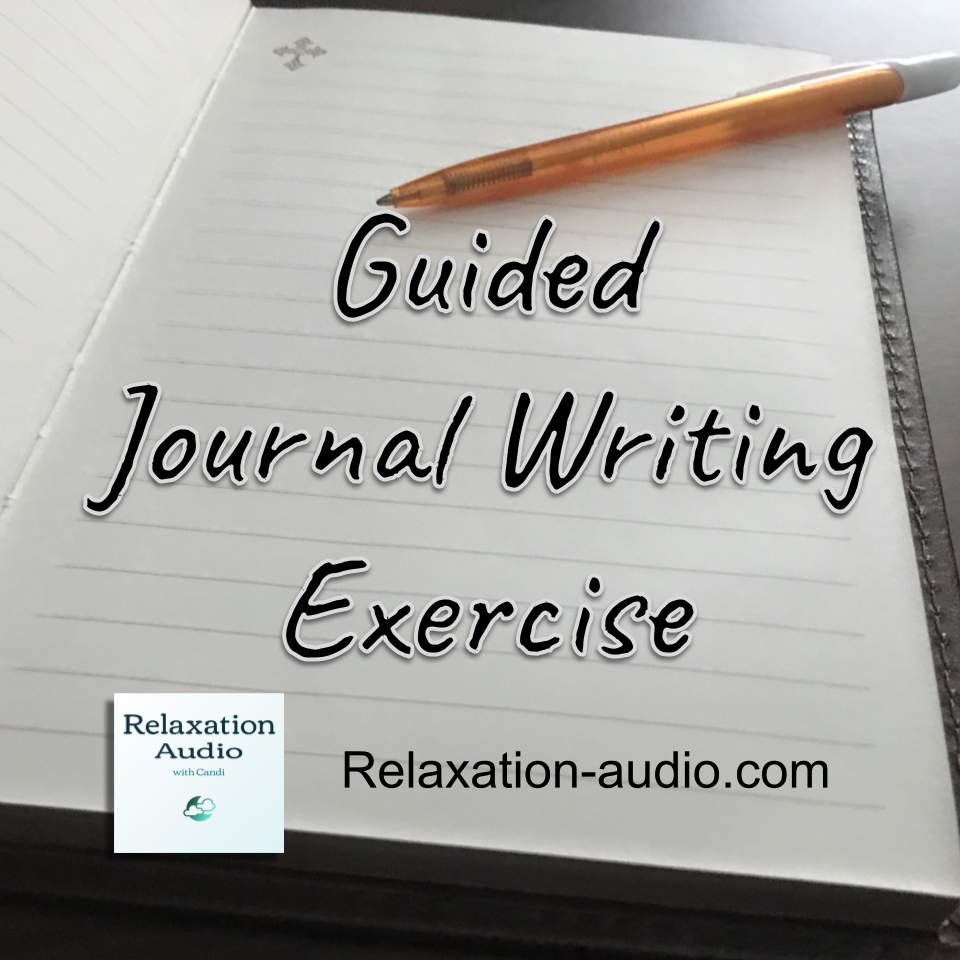A guided journal writing exercise to help get you writing. Journaling can be helpful for self-reflection and coping. The exercise begins with relaxation techniques, and then includes a journaling exercise with music in the background.
For updates, videos, and relaxation techniques, you can find Relaxation Audio with Candi on Facebook at https://www.facebook.com/relaxationaudio.
Subscribe to the Relaxation Audio with Candi podcast for a new relaxation download each week.

Guided Journal Writing Exercise Script
This exercise will involve relaxation, followed by writing. There will be a few prompts to get you started, then 2 minutes of writing with background music and additional ideas to write about, followed by 8 minutes of writing with only background music. There will be a final writing prompt to conclude.
You can choose to write about whatever you want. The prompts can provide ideas, but you don’t have to use them.
It is normal to have times when journaling goes well and is enjoyable, and times when it is harder or less enjoyable. That’s okay. If you feel uncomfortable or anxious when writing, remind yourself that there is no right or wrong way to journal, and that it is okay to have these feelings.
If you keep your writing, you can look back on your progress. A regular habit of writing will make it easier to journal and will help you be more creative. Regular journaling can also reduce stress and help you cope more effectively with challenges.
Before we begin the relaxation exercise, get the supplies you will need. You can use a journal, a notebook, or some sheets of paper. Get a pen or pencil. You can use coloured pencils, markers, or pens if you want, but you don’t have to. Writing by hand is ideal because there will be fewer distractions than writing on a computer, and the physical act of writing on paper can be helpful as well.
Find a place where you can work undisturbed. You may want to sit at a desk with only your notebook and writing tools. Take away distractions by turning off notifications or putting devices away or on airplane mode.
Relaxation Exercise: Relax Before You Write
Take a few moments to relax before you begin.
Stand with your feet about shoulder width apart. Breathe in as you stretch your hands high above your head. Exhale slowly as you slowly lower your arms to the sides, fully emptying your lungs as your arms reach your sides.
Reach up again, breathing in. Stretch. Slowly lower your arms as you exhale.
Stretch again as you breathe in, reaching up as high as you can. Stand on your tiptoes to reach even higher. Relax as you breathe out, lowering your arms.
Take slow, steady breaths as you roll your shoulders forward. Keep breathing, and switch directions now, rolling your shoulders back. Work out the tension in your muscles as you roll your shoulders. Now stop, letting your shoulders relax. Take a deep breath in, and as you exhale, relax your shoulders and allow your shoulder muscles to become loose. Keep breathing. Let go of any remaining tension in your shoulders, lowering your shoulders and moving them slightly back.
Continue to relax as you sit down to prepare for writing.
Sit down now in the place where you will do journal writing, but for now, just focus on relaxing. Close your eyes for a moment, and breathe. Notice how you are feeling right now. Many people find that it is hard to focus on journaling because they are busy, or they don’t know what to write, or their mind is racing. Relaxing can help to bring mental clarity.
Relax by counting each breath, every time you breathe out. Breathe in, and breathe out. One.
Breathe in again, and out slowly. Two.
Keep breathing slowly, at your own pace. I will remind you to keep counting. Continue until I say stop.
(Pause)
Continue to count your breaths. As you count, let your muscles relax.
(Pause)
Release tension from your muscles, allowing them to relax as you continue to count each breath. If you lose count, just start again at one.
(Pause)
Continue to count your breaths.
(Pause)
Now stop. Good.
Notice again how you are feeling. You may feel the same as when you started, or you might feel different. However you feel is okay. Just notice how you feel.
(Pause)
Get Ready to Write, and Begin the Guided Journal Writing Exercise.
Open your eyes, and take a pen or pencil. Write today’s date at the top of the page if you want to.
The purpose of this guided journal writing exercise is to purposefully set aside some time to journal, and to experience the benefits of journaling. You may have additional purposes for today’s time. Maybe you want to explore your thoughts or feelings in general or in relation to a particular issue. Perhaps you want to reflect on a challenge or problem. You might want to relieve stress or improve your coping skills. There are many possibilities. Write down your thoughts about the purpose of this guided journal writing exercise. If you aren’t sure about the purpose, go ahead and write that you aren’t sure. It doesn’t matter what you write. Begin writing now about the purpose of today’s exercise.
(Pause)
As we go, you can write whatever you want. You can use complete sentences, bullet points, single words, multiple words, scribbles, drawings, or whatever else is effective to express yourself. There is no right or wrong way to do this exercise.
Write a bit about how you feel right now. Remember to mention how you feel both physically and emotionally.
(Continued)
The script continues in the video below.
You may also like:







